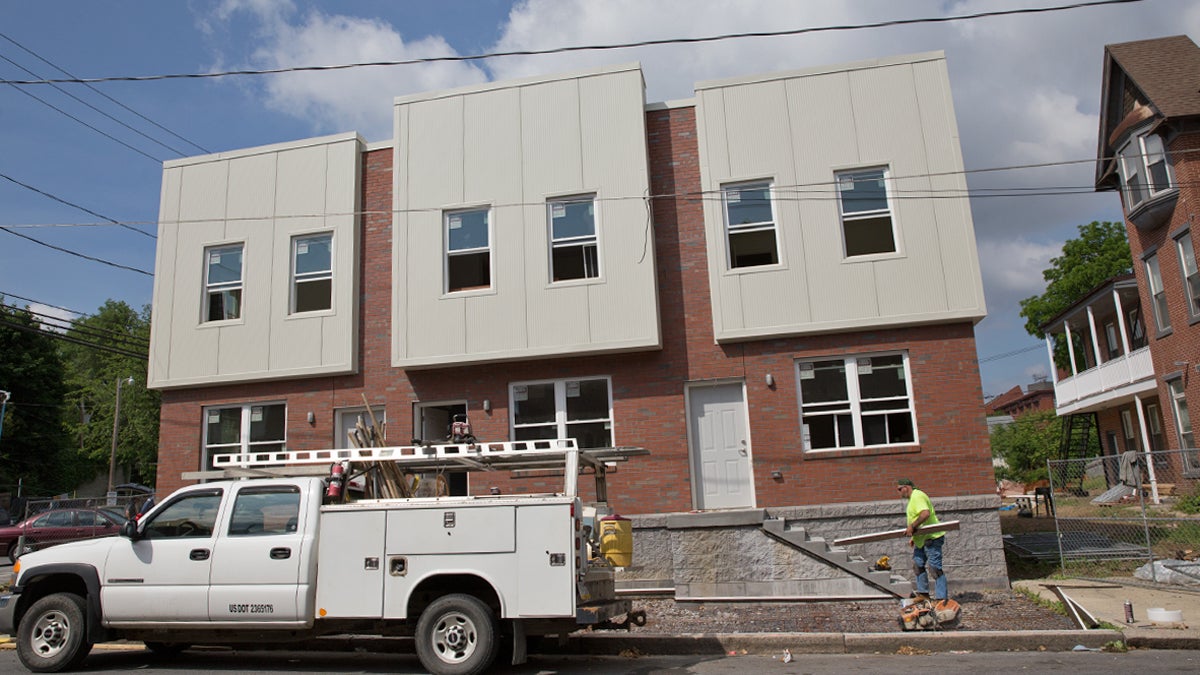Pennsylvania building codes prove difficult to update

New construction in the South Allison Hills neighborhood in Harrisburg, Pa. Pennsylvania has a unique law that slows — and even stops — changes to the state building code. (Lindsay Lazarski/WHYY)
Pennsylvania has a unique law that slows — and even stops — changes to the state building code.
Building codes seem simple enough: build buildings that are safe to live in. To keep up with changing technology, most states update those codes every three years.
But Pennsylvania has gone six years without updates as the state wrestles with a law that creates an unusually high bar to approve changes. Each individual update must be voted on by the Review and Advisory Council and passed with a two-thirds majority. The council has one year to read and vote on close to 2,000 changes.
Act 1
Every three years, the International Code Council issues recommended changes to the whole country. States decide which recommendations they’ll incorporate into their building codes.
Previously, Pennsylvania automatically adopted all changes unless the RAC actively voted them out.
In 2011, Act 1 changed the law so that no updates were adopted unless voted in with a two-thirds majority of the RAC board. That’s a higher standard than the legislature has to pass state laws.
In 2012, the RAC adopted no changes to the building codes. In 2015, subcommittees made up of RAC members suggested the adoption of over 90 percent of the changes. The RAC adopted only 16 of the 1902 changes.
How does that happen?
Part of the problem is the time limit. The unpaid 19-member RAC has one year to review thousands of changes. Critics say the other problem is that five of the 19 seats on the RAC are from the construction industry — a group that usually advocates against updates to the building code. They make up the largest bloc on the committee, and are just one vote away from preventing a two-thirds majority.
Going six years without updates isn’t the end of the world. But check the wording of Act 1: the RAC can only consider new changes each cycle. Any updates that weren’t passed the cycle before are off the table. And updates build on updates, so the longer Pennsylvania goes without updating their codes, the more codes won’t be able to be updated.
‘The Worst In The Country’
Members of the RAC have written to the Wolf administration, saying that Act 1 makes it impossible for them to do their jobs fully.
Others seem to agree. The Clean Air Council, a Pennsylvania environmental group, is suing the RAC and the state Department of Labor and Industry. It claims that Act 1 is unconstitutional due to it’s imprecise and ambiguous wording. And even if the law is constitutional, they say the RAC failed to follow it by rejecting changes that fit their requirements.
“Pennsylvania was among the best states when they first started,” says Logan Welde, a lawyer for the Clean Air Council. “Now, Pennsylvania’s building code adoption system is the worst in the country. It is the most arduous system out there.”
Their concern began with lost energy efficiency, but once the Clean Air Council started to look at building codes, they realized just how controversial these updates can be.
How important are updates?
Generally, building code updates are recommended every three years to incorporate new technology and new knowledge to make houses safer. Recent updates have focused on increased energy efficiency and natural disaster resiliency.
“The 2015 [ICC recommended] codes contained a lot of updates that FEMA recommended after Hurricane Sandy,” says Shari Shapiro, a policy consultant on energy, environment and construction issues. “FEMA has determined that building codes are among the best and most cost-effective ways to create more resilient building stock.”
Investing in resiliency can pay off for homeowners and municipalities. One example is the Building Code Effectiveness Grading Schedule. A group called the Insurance Services Office grades communities based on their code adoption and enforcement. Those grades influence how much FEMA funding a community would get after a natural disaster, and can lower insurance rates on homes.
In Pennsylvania, a state that’s struggling with rising flood insurance rates, every little bit helps homeowners stay in their houses. Building codes help save money in other ways, like your utility bills.
Welde, of the Clean Air Campaign, says that the 2015 building code updates could increase energy efficiency by up to 30 percent.
“Buildings last for decades, if not longer,” says Welde. “That’s a tremendous amount of energy savings over time that Pennsylvanians missed out on.”
But many people in the construction industry say these recent updates are too much—and too frequent—for them to stay on top of.
“The cost of all these changes is very high,” says Doug Meshaw, of the Pennsylvania Builders Association. “That gets passed on to the consumer and will price many people out of home ownership.”
And, he points out, building codes are a minimum standard.
“We will build anyone a home to any standard that they want,” he says. “If they want an energy efficient home built to the 2015 standard, we are happy to build that.”
Meshaw agrees that Act 1 isn’t necessarily working. But he doesn’t want to go back to the old ways.
“We would like to see a six-year update cycle,” says Meshaw. “There could be a three-year minor update to change punctuation or little changes, but they’d have more time to consider major changes.”
Shapiro says the problem comes if Pennsylvania misses that six-year update, or fails to add new codes like they’ve done in 2012 and 2015. The state could go 12 years without a major update to the building codes.
Clean Air Council’s lawsuit is still pending and there is some discussion in Harrisburg of changing parts of Act 1. But for now, it seems Pennsylvania’s arduous system of updating building codes is here to stay.
“The Clean Air Council is very worried that Pennsylvania is now, and will be, stuck in bad code land,” says Welde. “Energy efficiency is our goal, but we don’t want to see the whole state held back by these out-of-date codes.”
Meshaw says that’s a bit dramatic.
“The 2009 codes aren’t bad,” he says. “Houses built to 2009 [standards] are good and strong, and they’re not going anywhere.”
WHYY is your source for fact-based, in-depth journalism and information. As a nonprofit organization, we rely on financial support from readers like you. Please give today.


